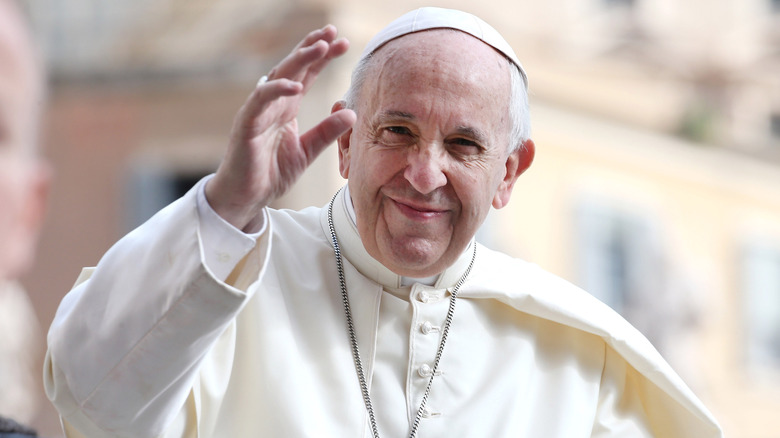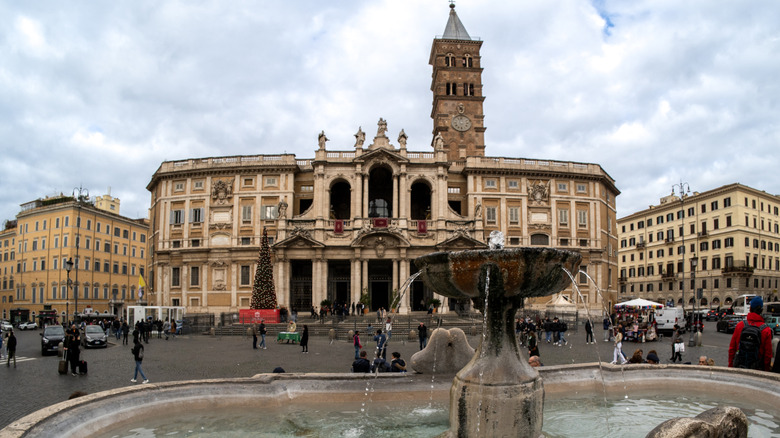The Items Pope Francis Will Be Buried With Explained
When Pope Francis died on April 21, 2025, he left behind a unique legacy of back-to-basics Christianity, humility, and forward-mindedness. He eschewed residence in the lavish and gold-laden Apostolic Palace in Vatican City and instead, the Pope lived in a 538-square-foot cardinal guest room in Casa Santa Marta, a plain, white-walled space filled with basic necessities. He wanted his funeral to be equally simplified and stripped of ornate rites because the pope is a "pastor and disciple of Christ and not of a powerful person of this world," as Vatican News quotes. This includes where he's buried, funeral rites performed during his burial, and what items he'll be buried with.
First off, Pope Francis's body will not be buried in St. Peter's Basilica like many other popes, but Santa Maria Maggiore, a pilgrimage site in Rome. He also won't be buried in the typical pontifical three-layered coffin, but a zinc-lined wooden casket. The funeral itself will have three steps, or "stations," resulting in his body being carried to Santa Maria Maggiore and interred in a crypt. The first station is already underway, as Pope Francis' body is currently on display for three days in St. Peter's Basilica.
Visitors who pay respects to Pope Francis can view at least two of the symbolic items that he's going to be buried in: his miter (the tall hat) and his rosary, which he is holding in his hands. Besides these items, Francis will be buried with a traditional bag of coins minted during his tenure and a document called a rogito that contains a record of his deeds.
Pope Francis will be buried with a select group of items
Each item that Pope Francis will be buried with has a particular meaning or value, either literal or symbolic. And since the pope described what to do with his body, we know that he deliberately chose what to place in his casket. He will not, for instance, be buried with the papal ferula (the staff with a crucifix on top). Usually, these staves are also placed with a pope's body when those bodies are lying in state, as Francis's is now, but Francis opted out of this decision, as well.
Francis will be buried with his miter, as mentioned, meant to symbolize what St. Paul calls in Ephesians 6:17 the "helmet of salvation." There are actually three different papal miters, from simple linen or silk worn to elaborate gold and gem-studded. Pictures of Francis' body show that he's wearing the simple, fabric miter. Also as mentioned, Francis will be buried with his rosary, the reason for which should be self-explanatory.
The pope's other two burial items skew esoteric. The bag of coins represents Francis' time as pope. There's one coin for each year of a pope's tenure, which in this case is 12 (Francis became pope in 2013). These coins aren't minted for a pope's funeral — each pope has a new line of coins minted upon becoming pope. Then there's the rogito, which is a document read aloud during the pope's funeral and contains a record of his life and deeds. One copy gets rolled up, put in a small canister, and placed in the pope's casket. Another copy goes to the Vatican archives.
Pope Francis outlined his wishes before death
We said that Pope Francis outlined the specifics of his funeral before death. These specifics are contained within a document called the Ordo Exsequiarum Romani Pontificis, which Francis updated and the Vatican published in November 2024. Previously, Pope John Paul II updated the document in 1998, which was then published in 2000. That version of papal funereal rites was carried out in 2005 when Pope John Paul II died and then in 2023 during Pope Benedict XVI's funeral.
While we can't access the full text of the Ordo Exsequiarum Romani Pontificis online, we know that it focused on streamlining and simplifying papal funerals, right down to the items buried with Pope Francis in his casket. Other adjustments include removing steps during the three stations we cited, swapping the three-layered coffin for a single, regular coffin, not placing the pope on an elevated platform during his funeral, and allowing for greater flexibility in reading prayers and performing music during his funeral.
It stands to reason that Francis considered the three non-rosary items he's buried with — his miter, the coins, and the rogito — relevant or harmless enough to be included with his body. None of the items in question defies Francis' overall goal of representing a simple, humble life. An item like the rogito, for instance, is more about respect and Vatican record keeping than anything. All in all, the choices suit him. The pope's funereal procession from St. Peter's Basilica to Santa Maria Maggiore is set for Saturday, April 26.


